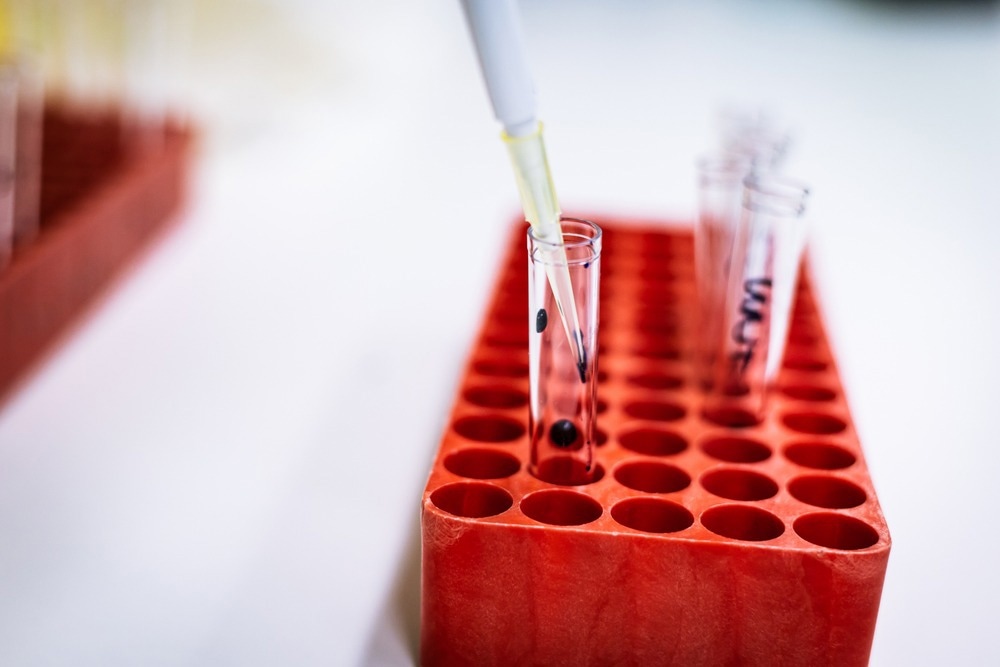Mass cytometry is the application of mass spectrometry analytical methods to the characterization of cells, which are delivered individually via flow cytometry apparatus, allowing a number of cellular parameters to be investigated simultaneously.

Image Credit: mh_enders/Shutterstock.com
Similarly to other cell characterization methods, such as fluorescent microscopy, structural features of interest are tagged within the cell using high-affinity small molecules, antibodies, or other proteins. However, instead of binding fluorophores that allow the presence and internal location of these features to be identified, the tags utilized in mass cytometry bear isotopically pure metal atoms that generate unique spectra during inductively coupled plasma mass spectrometry (ICP-MS) and time of flight mass spectrometry, thus allowing the presence and number of target features in the cell to be determined.
Ultra-small sample volumes are required to perform single-cell mass spectrometry, and a number of methods of facilitating single-cell delivery into mass spectrometry apparatus have been developed, such as electro-migration through a capillary tip (Li et al., 2020).
Mass cytometry usually specifically refers to the incorporation of mass spectroscopy characterization with flow cytometry, where cells are individually passed into the ionization chamber in a high-throughput manner using carefully engineered fluid streams that introduce a separating bubble of air between each cell.
Mass Spectrometry of Cells
ICP-MS operates by firstly ionizing the sample in argon gas by inductive heating using an electromagnetic coil, generating an electrically conductive plasma. Charged species from the sample are drawn towards the detector by an electric field of known intensity, separated depending on their mass-to-charge ratio.
Metals can be easily distinguished by the time they take to reach the detector with very high resolution across a wide dynamic range, from the low part per billion to the high part per million concentration range (Spitzer & Nolan, 2017).
Metals from yttrium89 to bismuth209 have been used to tag cellular features for identification with ICP-MS, and several dozen metals can be utilized simultaneously for multi-parameter measurement. This far exceeds the number of parameters researchers are able to simultaneously track in fluorescent microscopy, though unfortunately, as mass cytometry is a destructive process, the cells cannot be sorted for further examination as is usual during flow cytometry.
The lanthanides are commonly used in mass tags as they are rarely present in abundance in cells, possess a number of resolvable isotopes, and display comparable chemistry, though transition metals, semimetals, and halogens have been utilized.
Mass Cytometry Tags
Multiple metal atoms are often chelated by a branching polymer structure conjugated to the targeting antibody, ensuring that a large cargo of 100-250 atoms is bound. This is sufficient in highlighting abundant biomarkers with 10,000-10,000,000 copies per cell, though markers bearing a higher number of metal atoms must be utilized to detect more scarce targets.
Metal-chelating polymers are usually bound to antibodies via Michael addition through existing disulfide bonds on the protein, though utilizing conjugation strategies that target more abundant structural features such as cysteine residues can allow significantly greater loading.
Beyond carrying a large payload of a single metal to identify features within cells, mass tags are also designed to carry a unique combination of metals that generate a “barcode,” allowing highly accurate cell identification. For example, seven different lanthanides have been combined in 128 different ways on antibodies that target highly and uniquely expressed cell surface proteins, letting cells expressing these surface proteins be quickly counted by the unique spectra generated (Delgado-Gonzalez & Sanchez-Martin, 2021).
Inorganic nanoparticles are also utilized in mass cytometry, providing a large payload of metal atoms that can be easily detected by ICP-MS. Gold nanoparticles, in particular, bear a highly adaptable surface chemistry suitable for modification with targeting ligands and antibodies, facilitating applications in cell labeling.
Such nanoparticles are also of great interest in the biomedical field for applications in drug delivery, diagnosis, and therapy, and thus, understanding the ultimate biological and cellular fate of inorganic nanoparticles is an active area of research.
Compared to alternatives such as ordinary flow cytometry that employ light scattering to infer the presence of metal nanoparticles, mass cytometry is many orders of magnitude more sensitive, with a resolution of detection as low as only 4.2 gold nanoparticles of 3 nm in diameter per cell. Mass cytometry has, therefore, been utilized in mapping the biodistribution of bionanomaterials in vitro and in animal models (Yang et al., 2017).
Further Reading
Last Updated: Sep 26, 2023